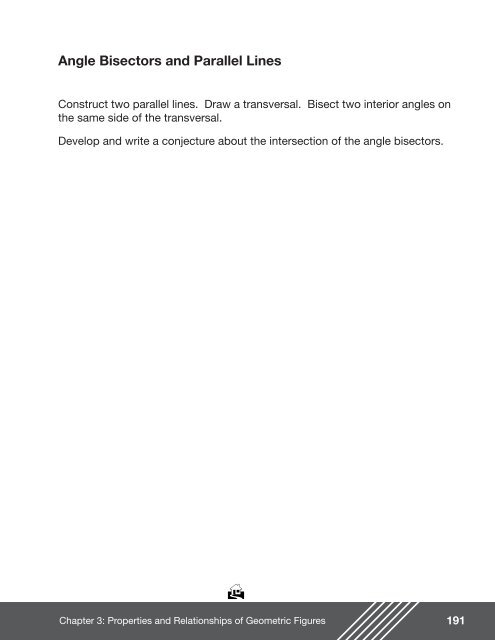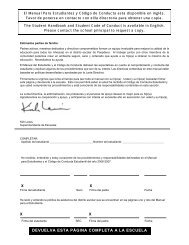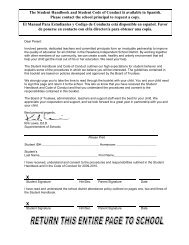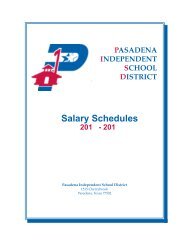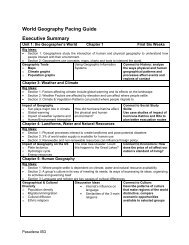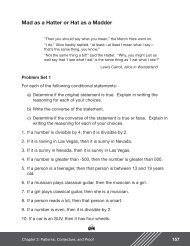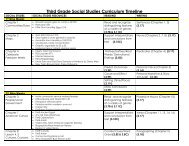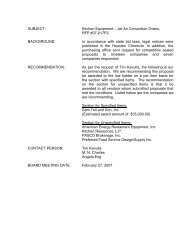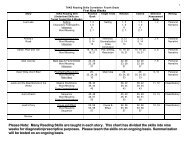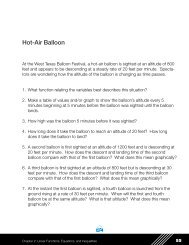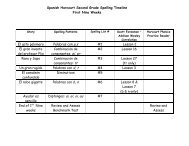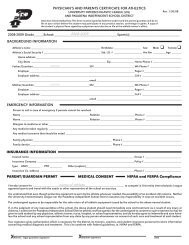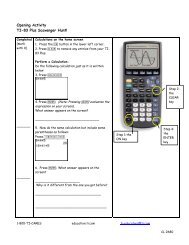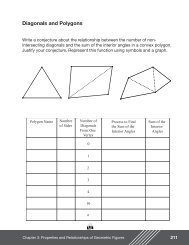Angle Bisectors and Parallel Lines
Angle Bisectors and Parallel Lines
Angle Bisectors and Parallel Lines
You also want an ePaper? Increase the reach of your titles
YUMPU automatically turns print PDFs into web optimized ePapers that Google loves.
<strong>Angle</strong> <strong>Bisectors</strong> <strong>and</strong> <strong>Parallel</strong> <strong>Lines</strong><br />
Construct two parallel lines. Draw a transversal. Bisect two interior angles on<br />
the same side of the transversal.<br />
Develop <strong>and</strong> write a conjecture about the intersection of the angle bisectors.<br />
H<br />
Chapter 3: Properties <strong>and</strong> Relationships of Geometric Figures 191
Teacher Notes<br />
Materials:<br />
Patty paper <strong>and</strong> one straightedge<br />
per student<br />
Or geometry software<br />
Connections to the Geometry<br />
TEKS:<br />
(e.2) Congruence <strong>and</strong> the<br />
geometry of size. The student<br />
analyzes properties <strong>and</strong> describes<br />
relationships in geometric figures.<br />
The student:<br />
(A) based on explorations <strong>and</strong><br />
using concrete models, formulates<br />
<strong>and</strong> tests conjectures about the<br />
properties of parallel <strong>and</strong><br />
perpendicular lines;<br />
Scaffolding Questions:<br />
• What does the given information imply about the angles<br />
in the figure?<br />
• Which special properties of parallel lines can you use to<br />
describe the relationships between or among the angles?<br />
Sample Solutions:<br />
Construct the figure using geometry software. Measure the<br />
resulting angles.<br />
First trial:<br />
(e.3) Congruence <strong>and</strong> the<br />
geometry of size. The student<br />
applies the concept of<br />
congruence to justify properties of<br />
figures <strong>and</strong> solve problems.<br />
The student:<br />
(A) uses congruence<br />
transformations to make<br />
conjectures <strong>and</strong> justify properties<br />
of geometric figures.<br />
A<br />
AM / / BN<br />
BD bisects<br />
AD bisects<br />
B<br />
∠NBA<br />
∠MAB<br />
D<br />
M<br />
N<br />
Second trial:<br />
A<br />
M<br />
D<br />
B<br />
N<br />
AM / / BN<br />
BD bisects<br />
AD bisects<br />
∠NBA<br />
∠MAB<br />
Conjecture: The two angle bisectors are perpendicular.<br />
H<br />
192<br />
Chapter 3: Properties <strong>and</strong> Relationships of Geometric Figures
Extension Questions:<br />
• Prove your conjecture using an axiomatic approach.<br />
1<br />
m∠ BAD = m∠BAM because AD bisects ∠BAM .<br />
2<br />
1<br />
m∠ MBA = m∠ABN because BD bisects ∠ABN .<br />
2<br />
The two interior angles on the same side of the transversal<br />
of two parallel lines are supplementary.<br />
Thus, m∠ABN + m∠ BAM = 180 °<br />
1<br />
1<br />
m∠ABN + m∠ BAM = 90°<br />
2<br />
2<br />
By substitution:<br />
m∠MBA + m∠ BAD = 90 ° (Equation 1)<br />
The sum of the angles of a triangle is 180 ° , so in ∆BDA<br />
m∠MBA + m∠BAD<br />
+ m∠ ADB = 180 ° . (Equation 2)<br />
Subtract Equation 1 from Equation 2.<br />
m∠ ADB = 90°<br />
Texas Assessment of<br />
Knowledge <strong>and</strong> Skills:<br />
Objective 6: The student will<br />
demonstrate an underst<strong>and</strong>ing<br />
of geometric relationships <strong>and</strong><br />
spatial reasoning.<br />
Objective 7: The student will<br />
demonstrate an underst<strong>and</strong>ing<br />
of two- <strong>and</strong> three-dimensional<br />
representations of geometric<br />
relationships <strong>and</strong> shapes.<br />
Objective 10: The student will<br />
demonstrate an underst<strong>and</strong>ing of<br />
the mathematical processes <strong>and</strong><br />
tools used in problem solving.<br />
Connection to High School<br />
Geometry: Supporting TEKS<br />
<strong>and</strong> TAKS Institute:<br />
I. Structure: Triangles Tell All<br />
Therefore ∠ADB is a right angle <strong>and</strong> the lines are<br />
perpendicular.<br />
• Connect the two points that are the intersection of the<br />
angle bisectors <strong>and</strong> the parallel lines. Describe the<br />
resulting triangles <strong>and</strong> the quadrilateral AMNB.<br />
A<br />
M<br />
D<br />
B<br />
N<br />
H<br />
Chapter 3: Properties <strong>and</strong> Relationships of Geometric Figures 193
The four triangles are congruent, <strong>and</strong> AMNB is a rhombus. The triangles AMD <strong>and</strong> ABD are<br />
congruent right triangles with common leg AD <strong>and</strong> congruent angles ( ∠DAB<br />
≅ ∠DAM<br />
) .<br />
AM = AB<br />
Also, the triangles NBD <strong>and</strong> ABD are congruent right triangles with common<br />
leg BD <strong>and</strong> congruent angles ( ∠DBA<br />
≅ ∠DBN<br />
) .<br />
BN = AB<br />
Therefore, AM = AB = BN.<br />
Because AM is parallel to BN <strong>and</strong> AM = BN, the figure is a parallelogram.<br />
AB = MN because they are opposite sides of the parallelogram.<br />
MN = AM = AB = BN<br />
The figure is a rhombus.<br />
Another way to conclude that it is a rhombus is to realize that it is a parallelogram with<br />
perpendicular diagonals.<br />
H<br />
194<br />
Chapter 3: Properties <strong>and</strong> Relationships of Geometric Figures
H<br />
Chapter 3: Properties <strong>and</strong> Relationships of Geometric Figures 195
Student Work Sample<br />
This student’s work shows the use of a compass to construct the parallel lines <strong>and</strong> bisect<br />
the angles.<br />
His work exemplifies many of the criteria on the solution guide, especially the following:<br />
• Identifies the important elements of the problem.<br />
The student underst<strong>and</strong>s what the problem requires. He underst<strong>and</strong>s the lines<br />
referenced in the problem--the angle bisectors <strong>and</strong> writes his conjecture about these<br />
bisectors.<br />
• States a clear <strong>and</strong> accurate solution using correct units.<br />
This problem requires a construction <strong>and</strong> a conjecture. The student’s construction is<br />
accurate, <strong>and</strong> his conjecture is clearly stated. Note the problem does not require that<br />
the student justify his conjecture, but he writes an explanation of how he came to his<br />
conjecture. The solution does not require units, but the student used the correct units<br />
in his justification.<br />
H<br />
196<br />
Chapter 3: Properties <strong>and</strong> Relationships of Geometric Figures
H<br />
Chapter 3: Properties <strong>and</strong> Relationships of Geometric Figures 197
H<br />
198<br />
Chapter 3: Properties <strong>and</strong> Relationships of Geometric Figures


